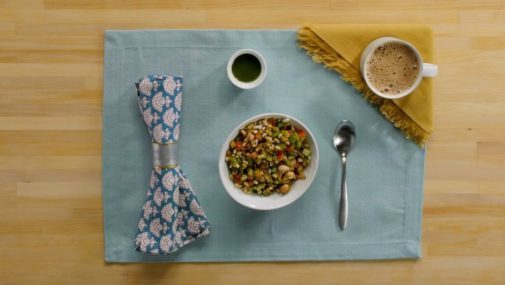Recipe: No – Rice Peas Pilaf

If you are someone who loves peas pilaf [pulav], Jeera rice or vegetable biriyani, but wished it had lower carbs, this recipe is for you and is the rice substitute that you have been longing for. The basmati rice has been swapped with shredded cabbage. This not only reduces the carbs and sodium content of the recipe, it drastically reduces the cooking time to just 20 mins from prep to plate.
So what’s the carb difference? This recipe has just 1/3 the carbs. For example, 1 cup of this cooked “No-Rice” peas Pilaf has less than 15 grams of carbs compared to 45 grams of carbs in the traditional rice pilaf.
This recipe of No-Rice Peas Pilaf is a great new addition to your healthy dinner. A cup of No-Rice Peas Pilaf has 1oz. protein and 1 cup of vegetable. It’s also the equivalent of a serving of vegetables and proteins on the USDA’s MyPlate, which provides guidance on the appropriate amounts of fruits, vegetables, grains, dairy and protein each person should consume to live a healthier, more balanced life.
Masala Omelet
Serving size: 1 Cup “No – Rice” Peas Pilaf
Total Servings: 3
Cooking Time: 20 Minutes
Ingredients:
- 3 cups cabbage, shredded
- 1 cup green peas
- 1-inch cinnamon bark
- ½ star anise
- 1 bay leaf
- 1 teaspoon Jeera or cumin
- 2 whole cardamom pods
- 1 whole clove
- 5 whole garlic cloves
- 1” ginger root, cut into 4 pieces
- 2 Green Thai chili, slit at the edge
- ¼ cup onion, diced
- 1/8 tsp salt
- ½ cup water
- 1 Tbsp olive oil
Cooking method:
- In a sauce pan heat 1 Tbsp olive oil, add ingredients #3 – #12, and sauté until onions are browned.
- Add peas and ½ cup water. When water comes to a boil, add shredded cabbage and stir well.
- Cover with lid and reduce heat to medium. Cook for 5 minutes then add 1/8 tsp salt.
- Optional garnish: add chopped cilantro and mint prior to serving.
Nutritional Information
| Serving size: 1 Cup No – Rice Peas Pilaf
Each serving provides: |
|
| Calories | 108 Kcal |
| Protein | 4g |
| Total Carb | 14g |
| Total Fat | 4.5g |
| Sodium | 109mg |
Other Resources:
MyPlate icons – https://www.choosemyplate.gov/myplate-graphic-resources
Nutrient info – USDA database – https://ndb.nal.usda.gov/ndb/search/list
Nutrient info – www.calorieking.com
Nutrient info – Patel Brothers – http://store.patelbros.com/
This South Asian series is brought to you by Advocate Health Care, created in collaboration with Boehringer Ingelheim.
Copyright © 2019 Advocate Aurora Health, Inc. and Boehringer Ingelheim Pharmaceuticals, Inc. All rights reserved.
Related Posts
Comments
About the Author
Sri Sakthi Ramanathan, RD, LDN earned her bachelor’s degree from UIC in 2008 and completed her 1 year nutrition internship with the Advocate group of hospitals. She has been a dietitian for 10 years and enjoys making meal planning easier and applicable for her clients. She currently works part time at Advocate Heart institute for their South Asian Cardiovascular Center as their community dietitian. She is the nutrition expert when it comes to South Asian community health.

















